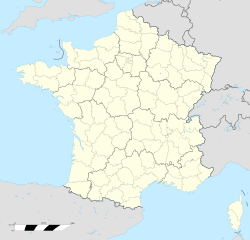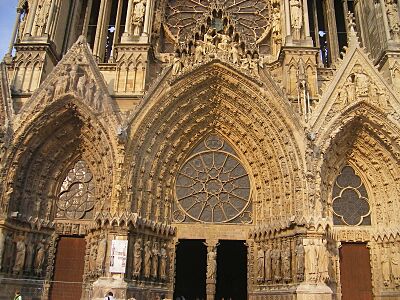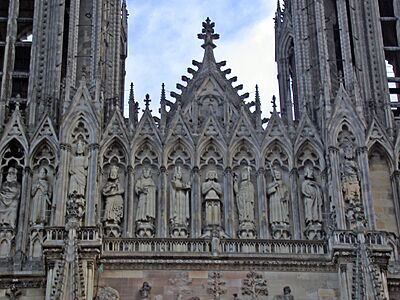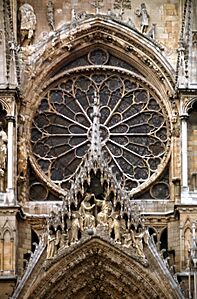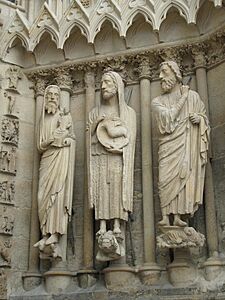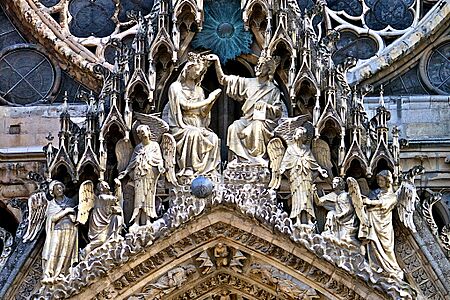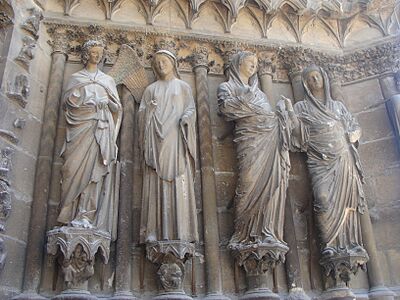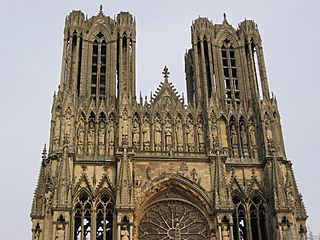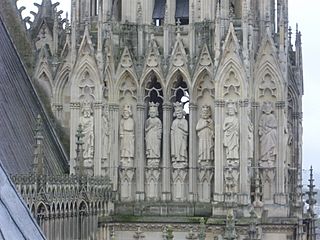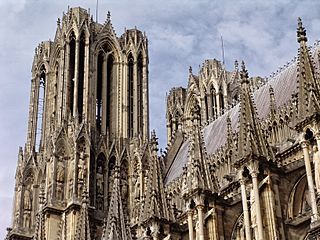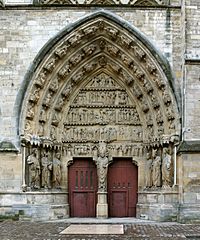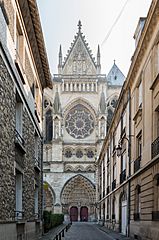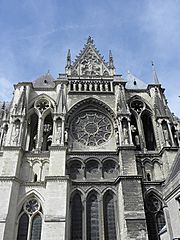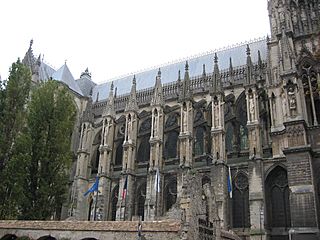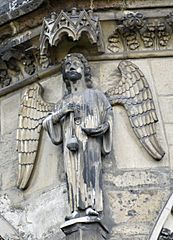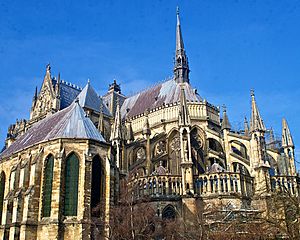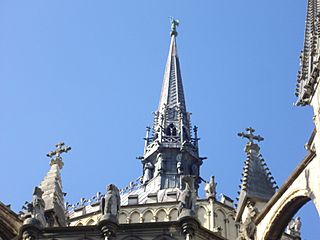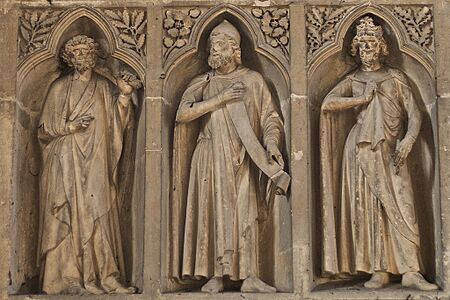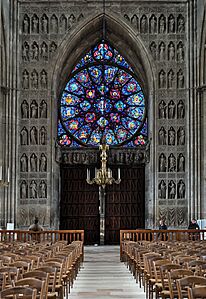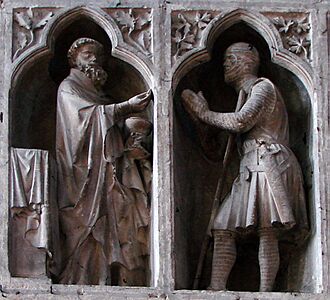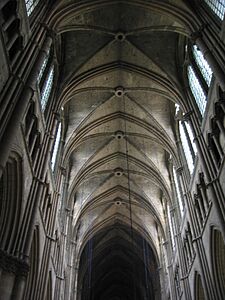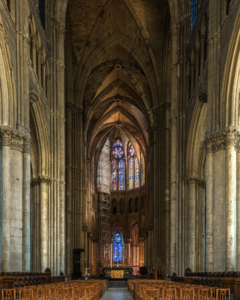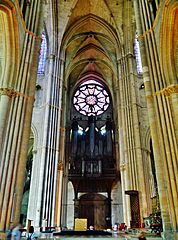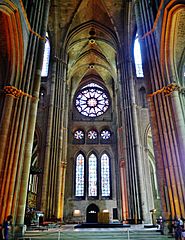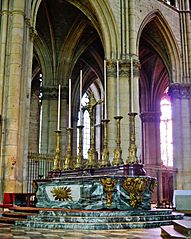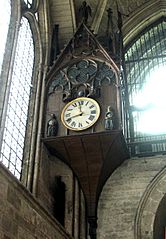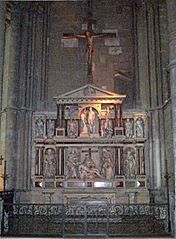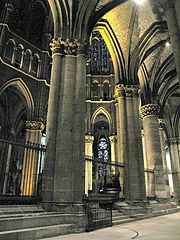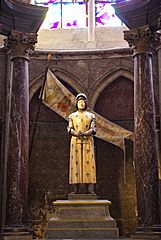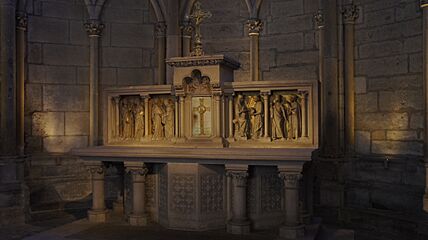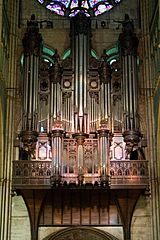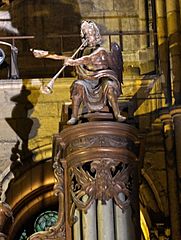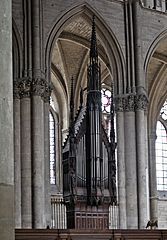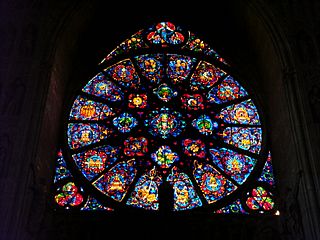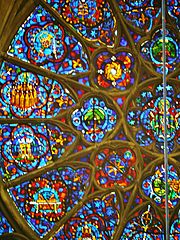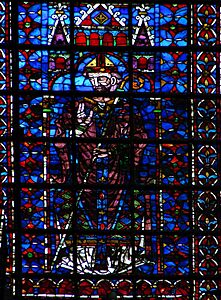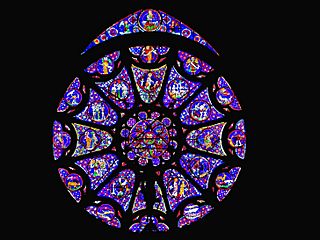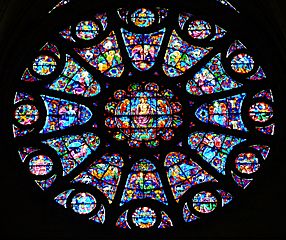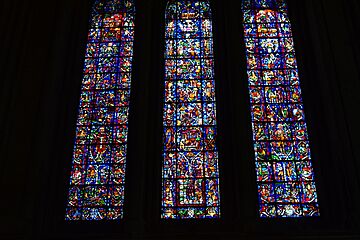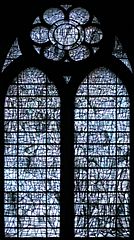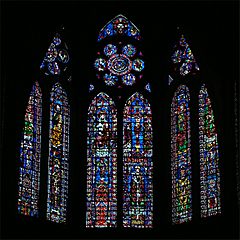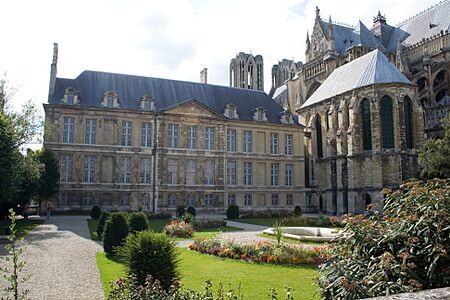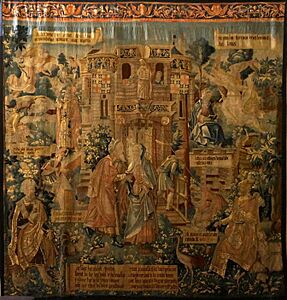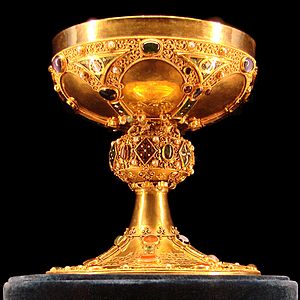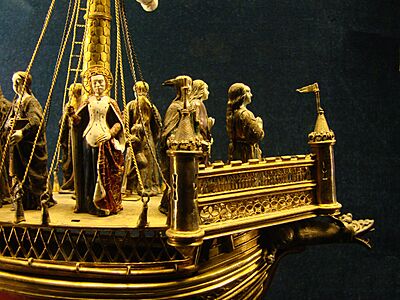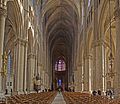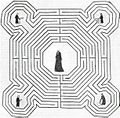Reims Cathedral facts for kids
Quick facts for kids Reims Cathedral |
|
|---|---|
| Cathedral of Our Lady of Reims | |
|
French: Cathédrale Notre-Dame de Reims
|
|

Façade of the cathedral, looking northeast
|
|
| 49°15′14″N 4°2′3″E / 49.25389°N 4.03417°E | |
| Location | Place du Cardinal Luçon, 51100 Reims |
| Country | France |
| Denomination | Catholic Church |
| History | |
| Status | Cathedral |
| Dedication | Our Lady of Reims |
| Architecture | |
| Functional status | Active |
| Architect(s) | Jean d'Orbais Jean-le-Loup Gaucher of Reims Bernard de Soissons |
| Architectural type | Church |
| Style | High Gothic |
| Years built | 1211–1345 |
| Groundbreaking | 1211 |
| Completed | 1275 |
| Specifications | |
| Length | 149.17 m (489.4 ft) |
| Floor area | 6,650 m2 (71,600 sq ft) |
| Number of towers | 2 |
| Tower height | 81 m (266 ft) |
| Bells | 2 (in south tower) |
| Administration | |
| Archdiocese | Reims (Seat) |
Reims Cathedral, also known as Notre-Dame de Reims, is a famous Catholic church in the city of Reims, France. It is dedicated to the Virgin Mary and is one of the most important examples of Gothic architecture.
For centuries, this cathedral was the traditional place where the kings of France were crowned. It is a very popular place to visit, with about a million people coming each year. In 1991, it became a UNESCO World Heritage Site, recognized for its special cultural value.
The first church on this site was built in the early 400s. About a century later, Clovis I, the first Frankish king, was baptized here by Saint Remigius. This event started the tradition of French kings being crowned in Reims.
The current cathedral was built between the 1200s and 1300s, replacing an older church that burned down. It was damaged during World War I but has been carefully restored. Today, the French government owns the cathedral, but the Catholic Church uses it. The government also pays for its upkeep and restoration.
Contents
History of Reims Cathedral
Early Churches and Royal Baptisms
The first Christian church in Reims was built around 250-300 AD. In the early 400s, Bishop Nicasius moved the main church to where the cathedral stands today. This new church was dedicated to the Virgin Mary.
Around 496 AD, Clovis I, the King of the Franks, was baptized here by Saint Remigius. This important event led to Reims becoming the traditional place for French kings to be crowned.
Building the Carolingian Cathedral
In 816, Louis the Pious, who was King of the Franks and Emperor, was crowned in Reims. The old church was too small, so a much larger one began to be built around 818. This new church was decorated with mosaics, paintings, and sculptures. It was officially opened in 862.
Later, in the 900s, an old underground room called a crypt was found beneath the church. It was cleaned up and dedicated to Saint Remigius. The main altar of the cathedral is still in the same spot, right above this crypt, as it has been for 15 centuries.
The cathedral became even more important because of the Holy Ampulla. This was a special container with sacred oil used to anoint French kings. Because Clovis was baptized here and the archbishop of Reims was powerful, Reims became the usual place for coronations. Almost all French kings, except for a few, were crowned here.
The High Gothic Cathedral (1200s-1300s)
On May 6, 1210, the older cathedral was destroyed by a fire. Just one year later, in 1211, Archbishop Aubrey started building the new cathedral. The construction moved very quickly because they used stones that were already cut to standard sizes.
In 1233, there was a disagreement between the church leaders and the townspeople. This caused work on the cathedral to stop for three years. It started again in 1236. By 1241, the choir area was finished, and the main part of the church (the nave) was roofed by 1299.
The names of the main architects who worked on the cathedral until 1275 are known. They were Jean d'Orbais, Jean-le-Loup, Gaucher of Reims, and Bernard de Soissons. Their names were once part of a special pattern on the floor called a labyrinth. This labyrinth was removed in 1779, but we know about it from old drawings.
The towers, which are about 81 meters (266 feet) tall, were originally planned to be much taller. The south tower holds two very large bells. One of them, named "Charlotte," weighs over 10,000 kilograms (22,000 pounds)!
During the Hundred Years' War, the English tried to capture Reims in 1359-1360, but they failed.
Joan of Arc and Later Centuries
In 1429, during the Hundred Years' War, Joan of Arc helped the French recapture Reims from the English. This allowed Charles VII to be crowned king on July 17, 1429. Joan of Arc is honored at Reims Cathedral with two statues.
In 1481, a fire damaged the roof and the central spire of the cathedral. However, kings Charles VIII and Louis XII helped pay for the repairs. The new roof was decorated with fleur-de-lis, which are symbols of French royalty.
In the 1700s, the inside of the cathedral was updated. Then, during the French Revolution in 1793, the cathedral was closed and used as a storage building. Many of its old furnishings and royal symbols were destroyed, and the bells were melted down to make cannons. However, most of the beautiful medieval sculptures survived.
1800s and World War I Damage
After Napoleon's time, royal coronations briefly returned to Reims. The last king crowned here was Charles X in 1825.
Throughout the 1800s, many parts of the cathedral were restored. Architects like Eugène Viollet-le-Duc worked to bring back its original medieval look.
When World War I began in 1914, the cathedral was used as a hospital. On September 19, 1914, German shells hit the roof, causing a huge fire that destroyed it. The bells melted, and windows were blown out. Images of the damaged cathedral were shown to highlight the destruction.
After the war, a big restoration project started in 1919, led by Henri Deneux. The Rockefeller Foundation provided a lot of money for the repairs. Modern materials like reinforced concrete were used to make the structure stronger. The cathedral was reopened in 1938.
Restoration work has continued since then, fixing war damage and pollution effects. In 1962, French President Charles de Gaulle and German Chancellor Konrad Adenauer met at the cathedral to symbolize peace between their countries. In 1991, the cathedral became a UNESCO World Heritage Site.
In 1996, Pope John Paul II visited Reims to celebrate 1500 years since Clovis's baptism.
Timeline of Reims Cathedral
- c. 250-300 - Saint Sixtus of Reims is recorded as the first bishop of Reims.
- 420 - Bishop Nicasius builds a new cathedral, dedicated to the Virgin Mary, at the present site.
- 496 - Clovis I, King of the Franks, is baptized by Bishop Remi.
- 816 - King Louis the Pious is crowned in the cathedral.
- 848 - Construction of a new, larger cathedral begins.
- 862 - The new cathedral is officially opened.
- 1140-1160 - Archbishop Samson rebuilds the west front and the choir.
- 1208 - First stone of the current cathedral is laid by Archbishop Aubry de Humbert.
- 1241 - The choir, apse, and parts of the nave and transept are completed.
- 1299 - The roof of the nave is finished.
- 1300-1350 - The Gallery of Kings is built.
- 1430-1460 - The upper west front towers are constructed.
- 1481 - A fire destroys the roof and the spire over the transept.
- 1504 - Reconstruction after the fire is completed.
- 1741–1749 - Medieval furniture is removed, and the interior is redecorated in a classical style.
- 1793 - During the French Revolution, the cathedral is used for storage, and its treasury is looted.
- 1825–1830 - Restoration of the west portals begins.
- 1845–1860 - Restoration of the upper church and towers.
- 1914–1918 - The cathedral is heavily damaged by artillery shells during World War I.
- 1918–1937 - Major repairs of war damage and new archaeological digs take place.
- 1962 - President Charles de Gaulle and German Chancellor Konrad Adenauer meet in the Cathedral for Franco-German reconciliation.
- 1996 - Pope John Paul II visits the cathedral to mark 1500 years since Clovis's baptism.
- 2011 - Restoration of the west portals begins, and six new stained glass windows by Imi Knoebel are added.
Cathedral Design
Plan of the Cathedral
The cathedral has a traditional cross shape. The long main part is called the nave, which leads to the transept (the arms of the cross). At the very end is the apse, which is rounded.
Outside the Cathedral
West Façade and Portals
The west façade is the main entrance to the cathedral. It looks very balanced with two towers of the same height and three main doorways, called portals. These portals are covered in detailed sculptures.
Above the central portal is a large rose window. Higher up, you'll see the Gallery of Kings, which has 56 large statues, each about 4.5 meters (15 feet) tall. Clovis I, the first Christian king of the Franks, is in the middle.
The sculptures on the three portals tell stories from the Bible. The central portal is dedicated to the Virgin Mary, the cathedral's patron saint. The south portal shows scenes from the Last Judgement and the Apocalypse of John. The north portal shows the Crucifixion of Christ. On the north side, you can also see the famous Smiling Angel, Gabriel, next to Mary. This angel was damaged in World War I but was repaired.
Towers and Transept
The two towers on the west façade are 81 meters (266 feet) tall. They were originally meant to be much taller, but the spires were never completed. The southwest tower holds two huge bells.
The north transept, like the west façade, has three portals with sculptures. These are dedicated to the Virgin Mary, Christian saints, and the Last Judgement. Above them is a large rose window with thin stone dividers, which was an early example of a style called Rayonnant Gothic.
Walls and Buttresses
The long walls of the nave are supported by eleven flying buttresses on each side. These are like stone arms that help hold up the tall walls and heavy roof, allowing for large windows. The buttresses are decorated with statues and spires. They also have channels to carry rainwater away from the building through sculpted gargoyles.
The Apse
The apse is the rounded east end of the cathedral. It has one main chapel and four smaller chapels around it. The outside is richly decorated with arches, spires, and many statues. A tall, slender spire, called a flèche, rises 18 meters (59 feet) above the choir. It was rebuilt in the 1400s and again in the 1920s.
Inside the Cathedral
West Wall Interior
Inside the west façade, there is a wall covered in sculptures. Some of these sculptures were damaged in the 1914 fire but have been restored. They continue the Bible stories from the outside and also show local saints. One famous scene shows Abraham (dressed as a knight) being offered bread and wine by Melchizedek, which is a symbol of the Eucharist.
The nave is the main part of the church where people sit. It is very long and has a consistent style. Its great height is possible because of the strong four-part rib vaults in the ceiling, supported by the flying buttresses outside. The columns in the nave are grouped together, making the church feel even taller. The tops of the columns, called capitals, are decorated with delicate plant sculptures.
Transept Interior
The transept is the part of the cathedral that crosses the nave. It is wider and taller than the nave. This area was specially used for the coronation ceremonies of the French kings.
The main altar is in the transept. It is a copy of the original altar, which was destroyed during World War I. On the northwest wall of the north transept, there is a medieval clock from the 1300s. It looks like a small church façade, and figures representing seasons and the Biblical Magi appear on the hour.
Choir and Chapels
The choir is the area reserved for the clergy. It has a double walkway, called an ambulatory, which leads to five chapels at the east end. The chapel dedicated to Joan of Arc contains her statue, showing her in armor with a banner.
The Organ
The main pipe organ is in the north transept, below the rose window. It was rebuilt after the 1481 fire and again after World War I. It is one of the largest organs in France, with over six thousand pipes. It is often used for concerts. A smaller organ is in the choir.
Stained Glass Windows
West Façade Windows
Many of the original stained glass windows remain in the interior of the west façade. The large rose window shows the Dormition of the Virgin (Mary falling asleep before ascending to heaven). The windows below it show the coronations of French kings.
Before World War I, most of the upper windows in the nave had their original glass. Each of the 36 windows showed a bishop at the bottom and a king of France at the top. Only four of these original windows survived the war intact. The others have been recreated using a mix of old and new glass.
Transept Windows
The north rose window in the transept shows the biblical Creation story and still has much of its original 13th-century glass. The central figure is God the creator.
Many of the upper windows in the transept are made of white glass, called grisaille. These were designed to let in as much light as possible, especially important for the coronation ceremonies held in the transept.
Some modern windows in the south transept celebrate the monk Dom Perignon and the history of French champagne. Other modern windows, created by Brigitte Simon, feature abstract patterns in white glass.
Choir and Chapel Windows
Some of the higher windows in the choir still have their original 13th-century glass.
Some of the most famous windows in the cathedral are modern ones in the axial chapel at the east end. These three windows were made by Marc Chagall and glass artist Charles Marq. They show the family tree of Christ, scenes from the Old and New Testaments, and important moments in Reims' history.
Palace of Tau and Treasury
The Palace of Tau is the former home of the archbishop, located next to the cathedral. It was also where banquets were held for new French kings after their coronations.
The cathedral has a beautiful collection of tapestries, which are large woven pictures. Some show scenes from the life of Clovis, and others show the life of the Virgin Mary.
The cathedral's treasury holds a collection of valuable objects, especially reliquaries (containers for holy relics). These include a fragment of the Holy Ampulla, which held the oil used to anoint French kings. There is also the Talisman of Charlemagne, a 12th-century piece with a supposed fragment of the True Cross. The "Chalice of Saint Remigius," believed to be used in Clovis's coronation, was also used in later coronations.
800th Anniversary
In 2011, the city of Reims celebrated the cathedral's 800th anniversary. There were concerts, performances, exhibitions, and light shows. Six new stained glass windows, designed by German artist Imi Knoebel, were also added. These windows are next to the Chagall windows in the apse.
Images for kids
-
Rose windows, west end
-
Villard de Honnecourt's drawing of a flying buttress at Reims, ca. 1230s (Bibliothèque nationale)
-
Flying buttress with pinnacle and a statue
See also
 In Spanish: Catedral de Reims para niños
In Spanish: Catedral de Reims para niños


